Menus
- Cheap bikes from Honda, Suzuki and Yamaha
- Honda NC 700 X versus Yamaha XJ6 Diversion F
- Suzuki Bandit 1250 S versus Honda CBF1000F
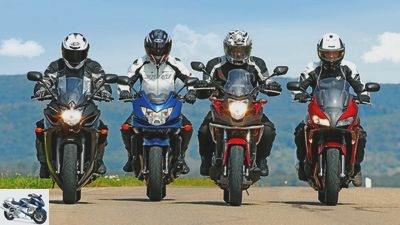
Engwer
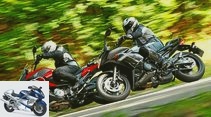
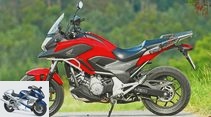
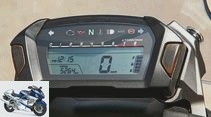
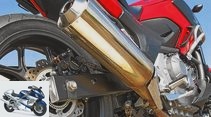
21st photos
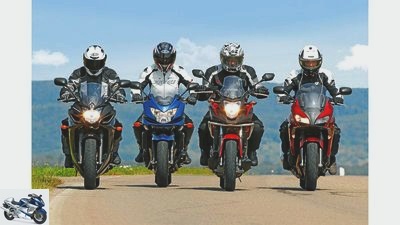
Engwer
1/21
Yamaha XJ6 Diversion F, Suzuki Bandit 1250 S, Honda NC 700 X and Honda CBF 1000 F.
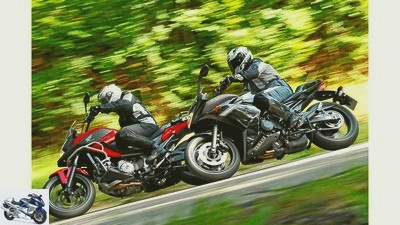
Engwer
2/21
Honda NC 700 X and Yamaha XJ6 Diversion F.
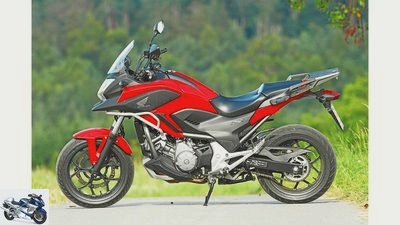
Engwer
3/21
Honda NC 700 X.
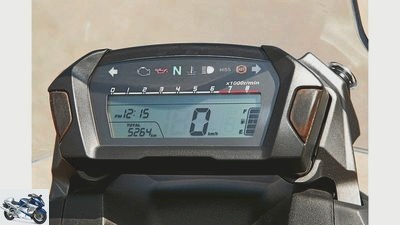
Engwer
4/21
Honda NC 700 X: The digital tachometer is difficult to read, the fuel gauge a little rough.
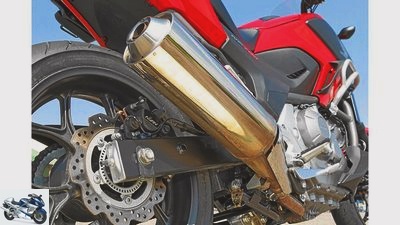
Engwer
5/21
Honda NC 700 X: Simple swing arm construction, but with ABS and stainless steel exhaust.
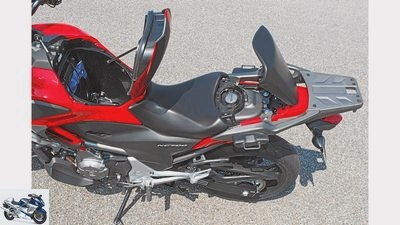
Engwer
6/21
Honda NC 700 X: The front storage compartment is practical, the tank under the pillion seat is not luggage-friendly.
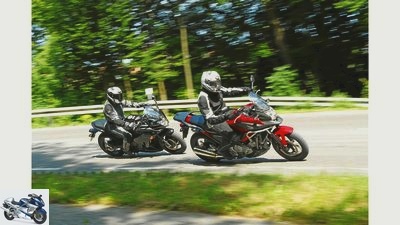
Engwer
7/21
Yamaha XJ6 Diversion F and Honda NC 700 X.
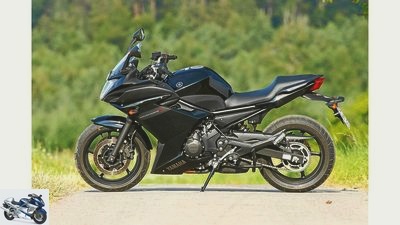
Engwer
8/21
Yamaha XJ6 Diversion F..

Engwer
9/21
Yamaha XJ6 Diversion F: Neatly made digital / analog cockpit that is not only visually impressive.
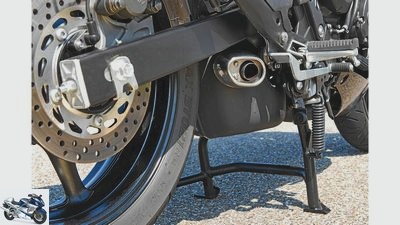
Engwer
10/21
Yamaha XJ6 Diversion F: The under-engine silencer looks bulky, the main stand is standard.

Engwer
11/21
Yamaha XJ6 Diversion F: The inline four-cylinder loves high revs and a sporty approach.
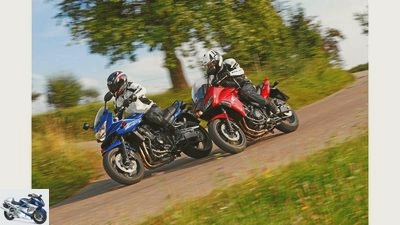
Engwer
12/21
Suzuki Bandit 1250 S and Honda CBF 1000 F.
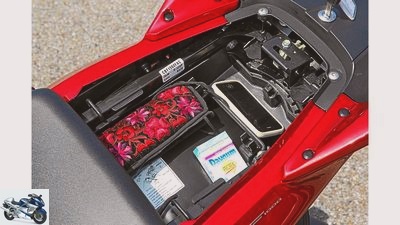
Engwer
13/21
Honda CBF 1000 F: A rain suit or the inevitable cell phone fits into the stowage compartment in the rear.
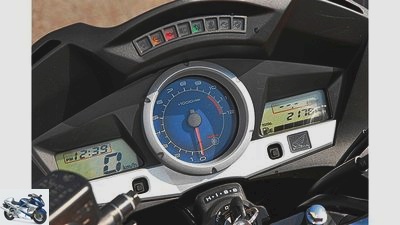
Engwer
14/21
Honda CBF 1000 F: Clear and informative, but like the Bandit without temperature and gear display.
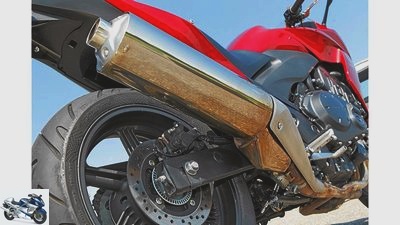
Engwer
15/21
Honda CBF 1000 F: The fat four-in-one exhaust spreads a touch of emotion.
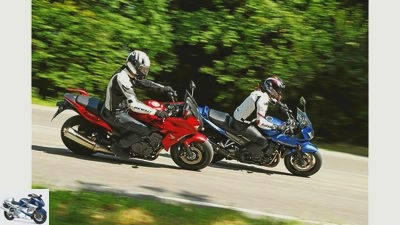
Engwer
16/21
Honda CBF 1000 F and Suzuki Bandit 1250 S.
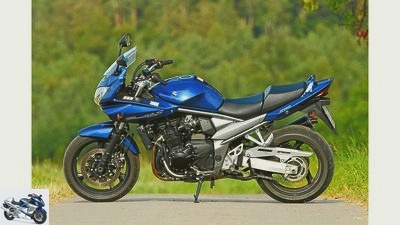
Engwer
17/21
Suzuki Bandit 1250 S..
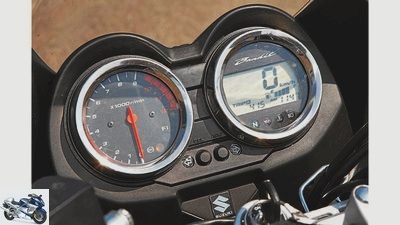
Engwer
18/21
Suzuki Bandit 1250 S: An analog, a digital round instrument – where is the logic??
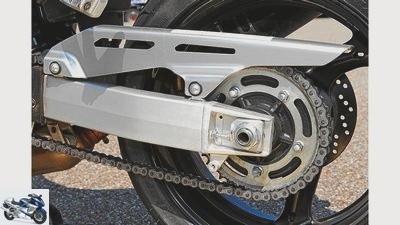
Engwer
19/21
Suzuki Bandit 1250 S: The aluminum swing arm gives the Suzuki another visual kick.
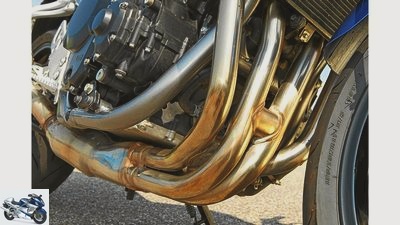
Engwer
20/21
Suzuki Bandit 1250 S: The artfully welded Bandit manifolds are a real eye-catcher.
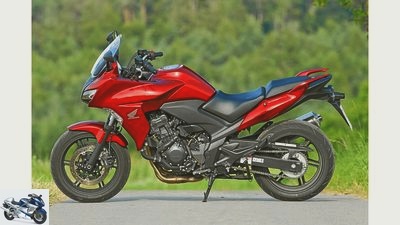
Engwer
21/21
Honda CBF 1000 F..
Comparison test of cheap touring motorcycles
Cheap bikes from Honda, Suzuki and Yamaha
It’s not often that many horsepower for so little money is available: a horsepower of the Suzuki Bandit 1250 S costs just 84 euros, while the Honda CBF 1000 F costs 96 euros. So hot goods for a highlight at the end of an equally hot summer.
Everything will be fine. And everyone will be happy. At least all motorcyclists, because there have not been such promising offers as at the moment for a long time. At the end of summer, Suzuki and Honda put two full-blown big bikes in the 100 hp class on a strict diet, which only affects the price and in no way the equipment: the Bandit 1250 S and the C.BF 1000 F drive a tough bargain price and have to show in comparison who the real bargain is.
Buy complete article
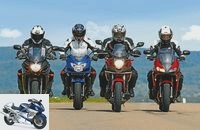
Comparison test of cheap touring motorcycles
Cheap bikes from Honda, Suzuki and Yamaha
NC 700 X, Yamaha is now responding by lowering the price of the XJ6 Diversion F. A lot of motorcycle for little money – you can still believe that luck?
Honda NC 700 X versus Yamaha XJ6 Diversion F
Engwer
Honda NC 700 X versus Yamaha XJ6 Diversion F.
Sure, people don’t faint from amazement when you come around the corner with the two test candidates. With a little luck, someone will even look over at them. In the ice cream parlor rating it is definitely only enough for a weak sufficient. A Suzuki Gladius or a Kawasaki ER-6f may have a stronger character, but cost at least 1000 euros more than the recommended retail price. The inconspicuousness of the Yamaha and the Honda is pure understatement. But at the latest when people hear the price of the motorcycles, they look up from their ice cream cups, look over in disbelief. Honda charges 6255 euros for the NC 700 X, Yamaha for the XJ6 Diversion F as Jokerbike 6520 euros (both including ABS and ancillary costs). For this course, however, there is hardly any room for negotiation with the dealer, which is still more the case with the aforementioned competitors. In the middle class, the motorcycle market currently offers an excellent price structure. Whether the quality suffers?
The inspecting walk around the bike, the attempt to expose a cheaply screwed together bike, therefore begins quite intuitively. And you search and search, you only find here and there little things such as a simply produced brake pedal (Honda) or cast footrest plates (Yamaha) that indicate the manufacturer’s red pen. And on the street? After pressing the button, the NC 700 X begins to whisper with its two-cylinder in-line, which is inclined forwards by 62 degrees. An acoustic boredom spreads that is second to none. No V2 staccato can be heard, although this is technically imitated with a 90 degree crank pin offset and an ignition offset of 270 degrees. The rear silencer unfortunately leaves nothing of that. But the Honda shines with other values. The sitting test leads to an energetic nod. Everything fits like a glove. The legs nestle against the narrow 21-liter storage compartment, where the tank normally sits. The footrests are mounted deep so that they are suitable for travel, the seat is taut but comfortable, the handlebars are not too high and are pleasantly cranked. The upright sitting position tempts you to diligently drive kilometers with the NC.
Especially since the tank below the pillion seat with 14.1 liters holds enough fuel to tear down a good 400 kilometers at a time. The average consumption of 3.5 liters is a peak. But – you already guessed it – the 48 hp won’t tear you off your feet. Nevertheless, this engine develops its own charm. The torque output is really excellent, never gives you the feeling of being underpowered over the entire speed range, even if it loses its revving power at the top. However, the early intervention of the limiter is the most disturbing. Overtaking maneuvers with the NC must be planned, but driving with it is still fun. Not only can it be controlled fantastically when driving slowly, it also offers a well-balanced damping between comfort and attack when the pace is tough, despite the lack of adjustment options. A crisp combi brake rounds off the package. In the long run, however, there is a lack of wind protection. The trailing edge of the airstream hangs in the middle of the helmet, which creates a really annoying background noise. Otherwise, the Honda remains a quiet step. Nobody notices it, and you can hardly hear it. You can like that, is understatement. It drives great, is solidly made – and the price is a real announcement. Whether the already somewhat grayed XJ6 Diversion F can keep up?
Engwer
Honda NC 700 X and Yamaha XJ6 Diversion F.
The Yamaha is classically styled with a sporty, dynamic touch. In contrast to the Honda, it has a full fairing, which does a much better job in terms of wind protection. The XJ6 also offers a feel-good package. Tourist-oriented knee angle, narrow, 17.3 liter tank and a sufficiently padded bench meet a cranked, but not too low-hanging handlebar. The result: a sitting position that is suitable for long journeys and is slightly inclined forwards. In combination with the 600 cubic in-line four-cylinder, there is almost a racing atmosphere compared to the Honda.
Do not jerk around leisurely, but shift down, step on the gas and enjoy the well-set four-cylinder sound, that is their motto. In order to stay tuned to the NC, the speed must be kept at a high level. Then the engine is a real pleasure for the athlete’s heart. With a nominal 78 hp, the power is really sufficient and enables good propulsion, and does not require the driver to pump up upper arms in the gym. This also applies to the brakes, although they don’t grip quite as energetically as the Honda’s. The Yamaha is only slightly more difficult to throw in an inclined position, but then pulls its line true to track. Because of the more gathered seating position, you feel a little better cared for on it in curves than on the NC. But the tide turns when the quality of asphalt declines and potholes, transverse joints and longitudinal grooves adorn the road. Here the chassis design of the Yamaha quickly reaches its limits. Your directly hinged shock absorber with non-adjustable damping is very comfortably tuned and underdamped for energetic cornering. Then the targeted line no longer fits at all, the motorcycle drives to where you don’t want it. After all, the suspension elements are completely overwhelmed in pillion mode. With the Honda, the set-up is much better. When it comes to fuel consumption, the Yamaha also has to admit defeat. With an average of 4.2 liters, it allows itself just under three-quarters of a liter more. Thanks to the larger tank, there are still an excellent 411 kilometers in one go. However, the luggage lock requires creativity, as there is not a single eyelet in the area of the stern. The Honda has at least a lashing option on the arms of the pillion footrest. There is a need for improvement in both of them, as they are otherwise very mature and real all-rounders.
After an extensive test drive, you circle the motorcycles again. So much motorcycle for so little money in comparison? This is really great and is fun even when doing the math. Both motorcycles deserve a recommendation.
Conclusion
Both motorcycles are real, solid all-rounders at an affordable price. The NC 700 X is aimed more at sensible buyers and beginners who want a successful overall concept and also like to be out and about in pairs. The XJ6 Diversion F, on the other hand, is looking for an active soloist who wants a classic appearance, who enjoys giving a good-sounding four-cylinder the spurs and prefers fine asphalt stretches.
Suzuki Bandit 1250 S versus Honda CBF1000F
Engwer
Honda CBF 1000 F and Suzuki Bandit 1250 S.
The big bandit was just one of Germany’s absolute favorites. In 2010, Suzuki sold almost 2500 units to men and women. Because things have been slowly going downhill since then, a special campaign is now starting that has paid off: A brand-new bandit currently only costs 8210 euros – or 84 euros per hp. Officially, the price should only apply to the silver 2011 model, but the blue 2012 model doesn‘t cost more on the Internet either. Technically, there is no difference between the two: Half-shell, ABS, plus 98 hp and a torque of 108 Newton meters – what more could a person want?
Maybe the Honda CBF 1000 F with 107 hp and 96 Newton meters of torque. The all-rounder, also an inline four-cylinder with a half-shell and ABS, was designed as a bandit competitor, but never reached its number of units. Now Honda is attacking the slightly battered competitor and is reducing the list price to 10,255 euros – the equivalent of 96 euros per horsepower. It is also worth taking a look at the internet here, because models with daily registration can be found in rows with a further 1000 euros special discount.
But is the Honda or the Suzuki the cheaper, because better offer? The hunt for the mother of all bargains begins. Out of the garage with the two big bikes and out onto the still glowing hot, midsummer asphalt strips. The following applies to both motorcycles: sit on it, drive off, feel good straight away, because the ergonomics are almost perfect. Lots of space, relaxed knee angles, a comfortable seat height for people of average height – these are the characteristics of a CBF and Bandit. On the Suzuki you sit closer to the handlebars, which gives it a sportier touch.
The four-cylinder in-line engines purr gently and calmly right from the start, but with different characteristics. The engine of the Suzuki runs rougher, but fully exploits its displacement advantage of 257 cm3 and puts a lot of pressure even at the lowest speeds. Practically from the start, it boasts at least 100 Newton meters of torque. A strong appearance as well as a start. The Honda can’t keep up with that, even if it has nine horsepower more. And while the Bandit around 4000 / min is enough for an enjoyable chase through the labyrinth of curves, the CBF wants to be kept happy with around 6000 / min. What is better now? It’s a matter of taste. Switching lazy driving allows both, which contributes significantly to the comfort.
On this point, the rivals generally do not take much, even if the Honda with its small storage compartment in the rear, which at least fits a rain suit, scores a few extra points with the height-adjustable seat and the same windshield. But the bandit pulls away when it comes to the big tour for two. On the one hand, the pillion rider sits closer to the driver, which makes for a better understanding of corners and a greater general sense of well-being. On the other hand, the Bandit allows 220 kilograms of payload – compared to the rather meager 196 of the CBF – and allows itself a lot of lean angle even with a passenger. While the Honda side and main stand have long been kissing the asphalt, the Suzuki is still waving carefree and, above all, without any ground contact on fast country roads. The fact that, thanks to its larger displacement with a passenger, it also offers better draft than the Honda, makes it the first choice for touring riders overall. Luggage systems with and without a topcase are offered by both manufacturers and accessories dealers.
The time of the CBF, on the other hand, strikes in solo operation, because this is where its hidden sporting character comes into play. After all, the engine comes from a thoroughbred athlete, namely the old Fireblade. It has been trimmed more for pulling power, but continues to run as smooth as silk and accelerates at all times without any jerking. The smooth forward thrust is also supported by the comparatively narrow 160 mm rear tire, with which the CBF takes all the bends and bends as if by itself: precisely, neutrally and perfectly balanced.
Engwer
Suzuki Bandit 1250 S and Honda CBF 1000 F.
The Bandit’s fat 180 rubber, on the other hand, calls for more courageous steering and occasional small repairs on the part of the driver. To prevent misunderstandings: It’s a robust drive and is a lot of fun. The difference is that while the Suzuki, with its great torque, feels sportier, the Honda is more agile and nimble.
The adjustment options for the chassis are not very different. On both motorcycles, the spring preload on the fork and shock absorber can be changed, and on the Honda, the rebound stage on the shock absorber can also be changed. Despite the more expensive lever system on the shock absorber, the Bandit passes bumps on to the spine more than the CBF, which is clearly ahead in the suspension rating. The brakes are tied. On the Honda, they can be dosed a little better and take more energetic action. In the event of a real panic braking, however, the bandit stops earlier because its ABS controls even more efficiently than that of the CBF.
That leaves the optics. Neither one nor the other can be considered radiant beauty. After all, the Suzuki with its shirt-sleeved lumberjack look and the twisted elbows flaunt its charms more conspicuously, the emotional spark jumps more easily with it. The CBF exudes a rather brittle charm and relies on one hundred percent functionality. There is no room for playful gimmicks, it looks compact, sober, logical. The heart does not open at the sight of them, rather the wallet, although Honda can be more emotional in the big bike category, and similarly cheap. The mighty CB 1300 S with its lovable 80s look was not officially downgraded, but is brand new on the Internet for as little as 10,000 euros. For the same price there are other big ships like the Yamaha Fazer or the Kawasaki Z 1000 – mostly not the newest model year, but with ABS.
With such fat prey, the summer can lead to a cooler autumn, the main thing is that tires and prices stay hot.
Conclusion
It’s best to take both at once. But seriously: The decision is difficult and is basically a matter of taste, because both motorcycles are based on rock-solid technology. With its large engine, the Bandit looks more attractive and feels sportier at first, but the CBF has the better and more dynamic chassis. Anyone who is under pressure from below and often drives in pairs should reach for the Suzuki. Sporty soloists, on the other hand, will be happier with the Honda.
Engwer
Honda CBF 1000 F..
Honda CBF 1000 F.
Four-cylinder four-stroke in-line engine, displacement 998 cm3, output 107 hp, max. Torque 96 Nm, weight with a full tank1 244 kg, payload1 196 kg, tank capacity 20.0 liters, service intervals 6000 km, price including ancillary costs 9990 euros.
MOTORCYCLE readings:
Top speed2 230 km / h, acceleration 0-100 km / h 3.5 seconds, 0-140 km / h 5.8 seconds, 0-200 km / h 14.0 seconds, pulling 60-100 km / h 4.2 sec, 100-140 km / h 4.7 sec, 140-180 km / h 5.8 sec, consumption country road 4.4 liters.
Engwer
Suzuki Bandit 1250 S..
Suzuki Bandit 1250 S (2011)
Four-cylinder four-stroke in-line engine, displacement 1255 cm3, output 98 hp, torque 108 Nm, weight with a full tank1 255 kg, payload1 220 kg, tank capacity 19.0 liters, service intervals 6000 km, price including ancillary costs 8210 euros.
MOTORCYCLE readings:
Top speed2 230 km / h, acceleration 0-100 km / h 3.5 seconds, 0-140 km / h 6.1 seconds, 0-200 km / h 14.2 seconds, pulling 60-100 km / h 4.0 sec, 100-140 km / h 4.3 sec, 140-180 km / h 5.4 sec, consumption country road 4.8 liters.
Engwer
Honda NC 700 X.
Honda NC 700 X
Two-cylinder four-stroke in-line engine, displacement 670 cm3, output 48 hp, torque 60 Nm, weight with a full tank1 218 kg, payload1 209 kg, tank capacity 14.1 liters, service intervals 12,000 km, price including ancillary costs 6255 euros, price of test motorcycle 7170 euros.
MOTORCYCLE readings:
Top speed2 160 km / h, acceleration 0-100 km / h 5.5 sec, 0-140 km / h 12.3 sec, pulling 60-100 km / h 7.7 sec, 100-140 km / h 14.5 sec, consumption on the highway 3.5 liters.
Engwer
Yamaha XJ6 Diversion F..
Yamaha XJ6 Diversion F (2010)
Four-cylinder four-stroke in-line engine, displacement 600 cm3, output 78 hp, torque 60 Nm, weight with a full tank1 221 kg, payload1 179 kg, tank capacity 17.0 liters, service intervals 10000 km, price including ancillary costs 6520 euros.
MOTORCYCLE readings:
Top speed2 205 km / h, acceleration 0-100 km / h 3.9 seconds, 0-140 km / h 7.3 seconds, 0-200 km / h 26.7 seconds, pulling 60-100 km / h 4.7 sec, 100-140 km / h 5.2 sec, 140-180 km / h 7.4 sec, consumption country road 4.2 liters.
Related articles
-
Comparison test Honda VTR 1000 F against Suzuki RF 900 R against Yamaha YZF 1000 R
Comparison test Honda VTR 1000 F against Suzuki RF 900 R against Yamaha YZF 1000 R Target group Sporty tourers? Athletes fit for travel? Grand …
-
Comparison test Honda CB 1300 S, Suzuki Bandit 1200 S, Yamaha FZ1 Fazer
Bilski comparison test Honda CB 1300 S, Suzuki Bandit 1200 S, Yamaha FZ1 Fazer search for traces They have sporty roots in common. At the Honda in …
-
Comparison test: naked bikes BMW, Suzuki and Yamaha
Markus Jahn 19 pictures Jahn 1/19 Large-stroke nakeds with classic designs and engines – the BMW R 1200 R Classic, the Suzuki Bandit 1250 and the Yamaha …
-
Honda CBR 650 F, Suzuki GSX 650 F, Yamaha XJ6 Diversion F in the test
fact 46 photos fact 1/46 The Suzuki as a solid all-rounder, the Yamaha as a lively fun bike. Honda is changing the CB 650 F with the casing, on the other…
-
Honda Crossrunner and Suzuki V-Strom 1000 in comparison test
fact 30th photos markus-jahn.com 1/30 Honda Crossrunner and Suzuki V-Strom 1000 in comparison test. markus-jahn.com 2/30 Honda Crossrunner and Suzuki…
-
Comparison test Suzuki SV 650, Honda CB 650 F, Kawasaki ER-6n, Yamaha MT-07
www.bilski-fotografie.de 34 pictures www.bilski-fotografie.de 1/34 They are the hottest candidates among the middle class naked bikes ….
-
Jahn comparison test Powercruiser Kawasaki VN 2000, Suzuki Intruder M 1800 R, Yamaha XV 1900 Midnight Star Punchtime Nobody distributes more displacement and …
-
Honda CB 1300, Suzuki Bandit 1250, Yamaha XJR 1300
Gargolov Honda CB 1300, Suzuki Bandit 1250, Yamaha XJR 1300 Comparison test of big bikes With a weight of five hundred pounds, a cubic capacity of 1,300…
-
Single cylinder in comparison: Honda XBR 500 and Yamaha SRX 6
Bilski On the move: Honda XBR 500 and Yamaha SRX 6 single-cylinder in comparison: Honda XBR 500 and Yamaha SRX 6 Contents of Is less motorcycle more fun? …
-
News from Honda, Kawasaki, Suzuki and Yamaha
Computer retouching: Guerin News from Honda, Kawasaki, Suzuki and Yamaha Faster with ABS A little more power and less weight ?? the new 1000s from …